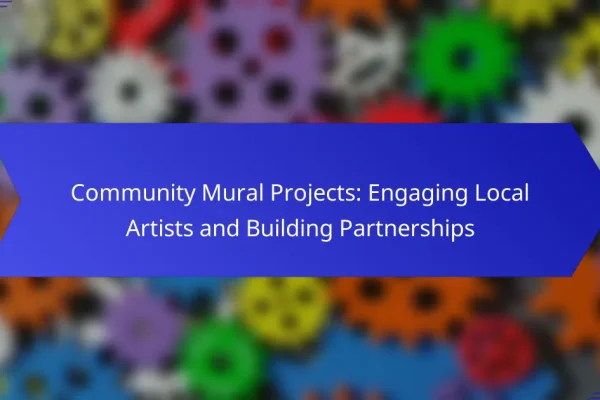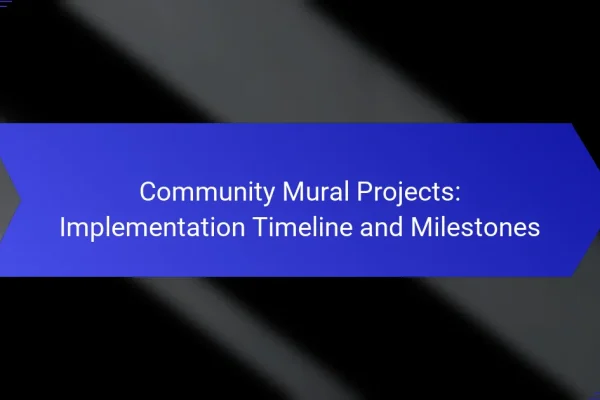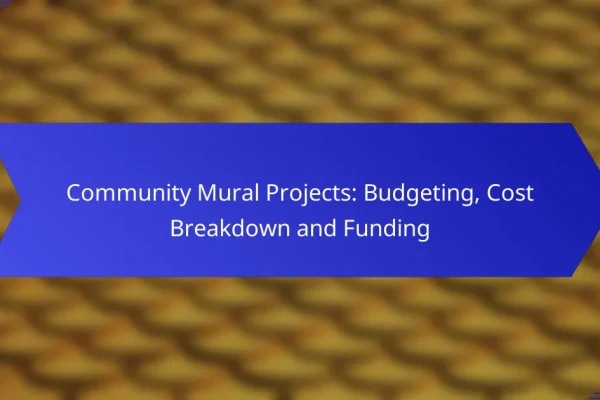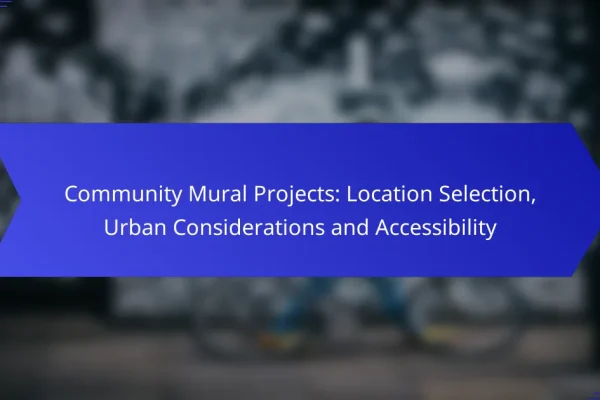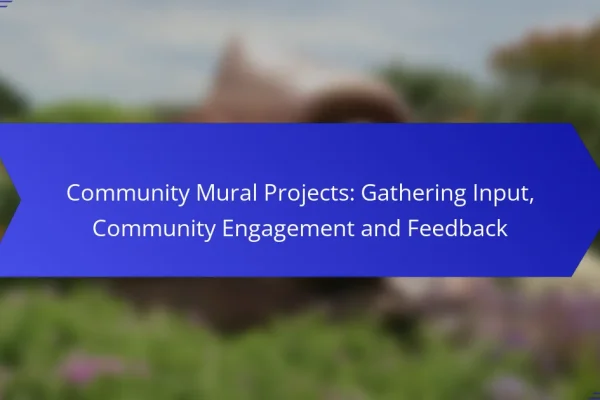How to plan a community mural project in urban areas?
Planning a community mural project in urban areas involves identifying the project’s goals, engaging local artists and stakeholders, and securing the necessary permits and funding. This process ensures that the mural reflects the community’s identity and values while adhering to local regulations.
Define project goals and themes
Start by establishing clear goals for the mural project. Consider what message or theme you want to convey, such as community pride, cultural heritage, or social issues. Engaging community members in brainstorming sessions can help identify themes that resonate with local residents.
Once themes are identified, create a vision statement that encapsulates the project’s purpose. This statement will guide the artistic direction and help communicate the project’s significance to stakeholders and potential funders.
Engage local artists and stakeholders
Involving local artists is crucial for the project’s authenticity and success. Reach out to artists through community centers, social media, or local art organizations. Hosting workshops or meetings can facilitate collaboration and allow artists to contribute their ideas and skills.
Additionally, engage stakeholders such as local businesses, schools, and community organizations. Their support can enhance the project’s visibility and provide resources. Consider forming a committee that includes representatives from these groups to ensure diverse perspectives are included in the planning process.
Secure necessary permits and funding
Before starting the mural, research local regulations regarding public art. This may include obtaining permits from city or municipal authorities. Check with local arts councils or community boards to understand the specific requirements in your area.
Funding is essential for covering materials, artist fees, and other project costs. Explore various funding sources, such as grants from arts organizations, crowdfunding, or sponsorships from local businesses. Creating a detailed budget can help identify funding needs and attract potential sponsors.
What are the best practices for community mural projects?
The best practices for community mural projects focus on engaging local residents and ensuring the artwork is built to last. By incorporating feedback from the community and selecting high-quality materials, projects can foster pride and withstand environmental challenges.
Incorporate community input and feedback
Engaging the community is crucial for the success of mural projects. Start by organizing workshops or meetings where residents can share their ideas and preferences for themes, colors, and designs. This involvement not only enhances the mural’s relevance but also builds a sense of ownership among community members.
Consider using surveys or social media polls to gather broader input. Make sure to communicate how community feedback will influence the final design, which can encourage more participation and investment in the project.
Choose durable materials for longevity
Selecting the right materials is essential for ensuring that the mural remains vibrant and intact over time. Use high-quality, weather-resistant paints and sealants that can withstand UV rays, rain, and temperature fluctuations. For surfaces, concrete or treated wood can provide a solid foundation that resists wear.
It’s advisable to consult with local artists or suppliers who specialize in mural materials to understand the best options available. Investing in durable materials may increase initial costs but can save money in the long run by reducing the need for repairs or repainting.
How to select a location for a mural?
Selecting a location for a mural involves assessing visibility, foot traffic, and community relevance. A well-chosen site can enhance the mural’s impact and ensure it resonates with the local audience.
Assess visibility and foot traffic
Visibility is crucial for a mural’s success; it should be placed where it can be easily seen by passersby. Locations near busy streets, parks, or community centers often attract higher foot traffic, increasing engagement.
Consider conducting a simple foot traffic survey to gauge the number of people who pass by potential sites at different times of the day. Aim for areas with consistent foot traffic, ideally in the hundreds or thousands daily, to maximize exposure.
Consider community relevance and accessibility
The mural’s location should resonate with the community and reflect its culture or history. Choosing a site that is meaningful to local residents can foster pride and encourage interaction.
Accessibility is also key; ensure the location is easy to reach for all community members, including those with disabilities. Sites near public transport or with ample parking can enhance accessibility and encourage more visitors to engage with the mural.
What are effective strategies for mural design?
Effective strategies for mural design include collaborating with local artists and ensuring that the artwork reflects the community’s culture and history. These approaches not only enhance the aesthetic appeal but also foster community engagement and ownership of the project.
Collaborate with local artists
Engaging local artists is crucial for creating murals that resonate with the community. Local artists bring unique perspectives and styles that reflect the area’s identity. Consider hosting workshops or meetings to gather input and ideas from artists who understand the local context.
When selecting artists, look for those with a strong connection to the community and a portfolio that aligns with the mural’s vision. This collaboration can lead to innovative designs and techniques that might not be possible with outside artists.
Reflect community culture and history
A successful mural should embody the culture and history of the community it represents. This can be achieved by incorporating local symbols, historical figures, or significant events into the design. Researching the community’s background and engaging residents in discussions can provide valuable insights.
To ensure the mural is meaningful, consider creating a theme that highlights shared values or experiences. This could involve storytelling elements or visual motifs that resonate with the community, making the mural a point of pride and connection for local residents.
How to promote community involvement in mural projects?
Promoting community involvement in mural projects is essential for ensuring the artwork reflects local culture and engages residents. Effective strategies include hosting interactive events and leveraging social media platforms to reach a broader audience.
Host workshops and brainstorming sessions
Workshops and brainstorming sessions are excellent ways to gather community input and ideas for mural designs. These events can be organized at local community centers or parks, allowing residents to share their thoughts and collaborate creatively. Consider scheduling multiple sessions to accommodate different schedules and demographics.
During these workshops, provide materials such as sketch pads, markers, and reference images to inspire participants. Encourage open dialogue and ensure everyone feels heard, as this fosters a sense of ownership over the project.
Utilize social media for outreach
Social media is a powerful tool for promoting community involvement in mural projects. Platforms like Facebook, Instagram, and Twitter can be used to share project updates, solicit feedback, and invite residents to participate in events. Create dedicated pages or groups to keep the conversation focused and organized.
Consider running targeted ads to reach specific demographics within the community. Use engaging visuals and clear calls to action to encourage participation. Regularly post updates and highlight community contributions to maintain interest and excitement around the project.
What are the funding options for mural projects?
Funding options for mural projects can include local arts grants and sponsorship from businesses. These avenues provide essential financial support to cover materials, artist fees, and other project expenses.
Apply for local arts grants
Local arts grants are often available through government agencies, nonprofit organizations, and arts councils. These grants can vary widely in amount, typically ranging from a few hundred to several thousand dollars, depending on the project scope and the funding body.
To apply, gather necessary documentation such as project proposals, budgets, and timelines. Be mindful of deadlines and specific eligibility criteria, as these can differ between grantors. Tailoring your application to align with the funder’s mission can significantly enhance your chances of success.
Seek sponsorship from local businesses
Local businesses can be valuable sponsors for mural projects, providing funding or in-kind support like materials and labor. Approach businesses that have a vested interest in community development or those that align with the mural’s theme.
When seeking sponsorship, prepare a clear proposal that outlines the benefits for the business, such as increased visibility and community goodwill. Offering to include their branding in the mural or promotional materials can be an effective incentive. Establishing a partnership can lead to mutual benefits and foster community ties.
